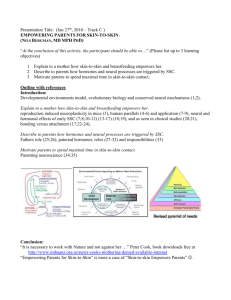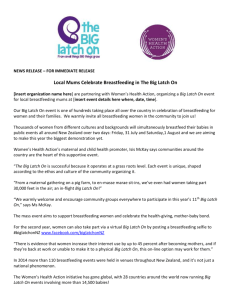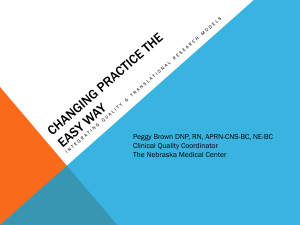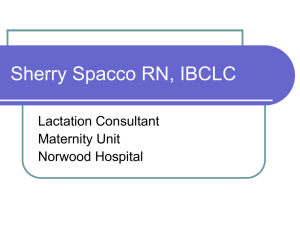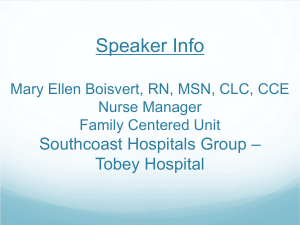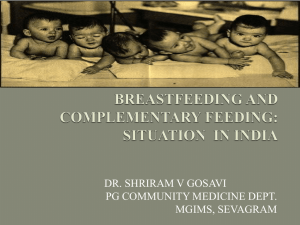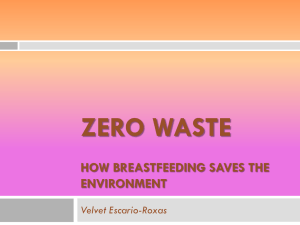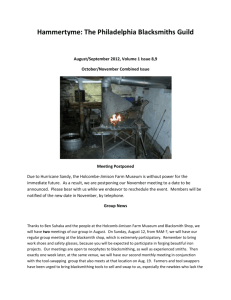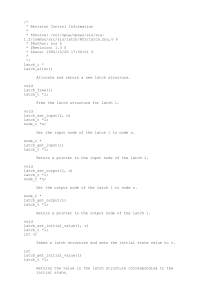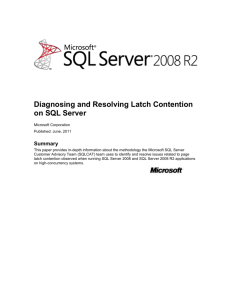Step 4 (Skin to Skin) Action Plan Template
advertisement
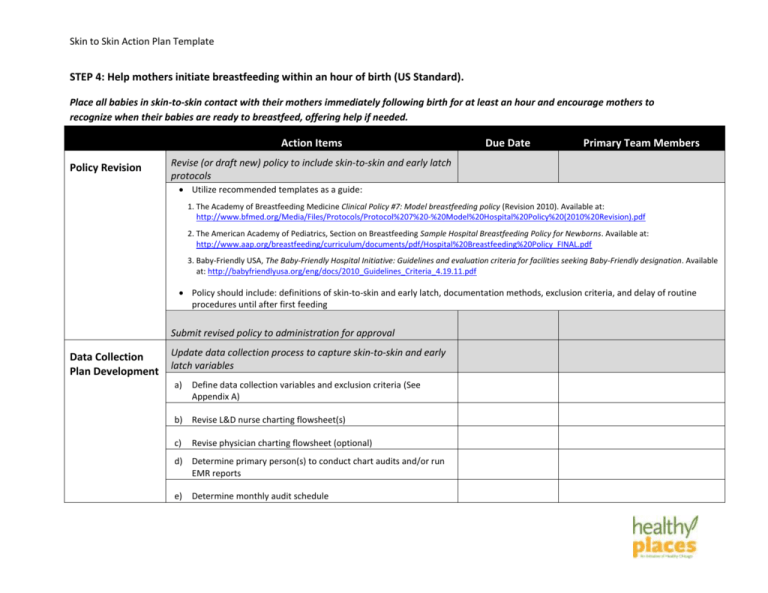
Skin to Skin Action Plan Template STEP 4: Help mothers initiate breastfeeding within an hour of birth (US Standard). Place all babies in skin-to-skin contact with their mothers immediately following birth for at least an hour and encourage mothers to recognize when their babies are ready to breastfeed, offering help if needed. Action Items Policy Revision Due Date Primary Team Members Revise (or draft new) policy to include skin-to-skin and early latch protocols Utilize recommended templates as a guide: 1. The Academy of Breastfeeding Medicine Clinical Policy #7: Model breastfeeding policy (Revision 2010). Available at: http://www.bfmed.org/Media/Files/Protocols/Protocol%207%20-%20Model%20Hospital%20Policy%20(2010%20Revision).pdf 2. The American Academy of Pediatrics, Section on Breastfeeding Sample Hospital Breastfeeding Policy for Newborns. Available at: http://www.aap.org/breastfeeding/curriculum/documents/pdf/Hospital%20Breastfeeding%20Policy_FINAL.pdf 3. Baby-Friendly USA, The Baby-Friendly Hospital Initiative: Guidelines and evaluation criteria for facilities seeking Baby-Friendly designation. Available at: http://babyfriendlyusa.org/eng/docs/2010_Guidelines_Criteria_4.19.11.pdf Policy should include: definitions of skin-to-skin and early latch, documentation methods, exclusion criteria, and delay of routine procedures until after first feeding Submit revised policy to administration for approval Data Collection Plan Development Update data collection process to capture skin-to-skin and early latch variables a) Define data collection variables and exclusion criteria (See Appendix A) b) Revise L&D nurse charting flowsheet(s) c) Revise physician charting flowsheet (optional) d) Determine primary person(s) to conduct chart audits and/or run EMR reports e) Determine monthly audit schedule Skin to Skin Action Plan Template Action Items Staff Training Train all staff on the importance of skin-to-skin, early latch, feeding cues, policy revisions and documentation changes a) Develop education plan to train all maternity nursing staff on revised policy, procedures and documentation methods (Examples: Staff meeting in-service, lunch & learn, email inservice) b) Implement education plan to train all maternity nursing staff on revised policy, procedures and documentation methods c) Track participation in training sessions to ensure all staff are trained d) Work with medical and non-clinical staff to ensure all physicians and staff are educated on policy changes Data Collection Plan Implementation Collect, analyze and report data at regular intervals (recommended: monthly) a) Collect data per previously determined method and schedule (Refer to Data Collection Plan Development) b) Report data summaries to breastfeeding multi-disciplinary committee c) Identify inconsistencies with policy compliance and documentation d) Examine barriers to implementing policy changes e) Patient Education Develop strategies to address identified barriers Inform patients of post-delivery procedures and the benefits of skin to skin and early latch a) Revise (or create new) patient education materials to include skin to skin and early latch information (See Appendix B for resources) b) Develop staff scripts to assist staff in notifying patients of skin to skin and early latch procedures post-delivery (optional) Due Date Primary Team Members Skin to Skin Action Plan Template Appendix A: Skin to skin and early latch data collection Sample data collection variable definitions and exclusion criteria: a. Skin-to-skin (%): 1. Hospitals may determine their own measurement criteria, but these are Baby-Friendly USA definitions: a) Vaginal – within 5 minutes continued through first feeding b) C-section – within 5 minutes of mother responsive through first feeding; NICU – opportunity for Kangaroo Care. 2. “Yes (1) ” or “No (0)” a) If Yes, when was skin to skin initiated? i. Within 5 minutes ii. 6-15 minutes iii. 16-30 minutes iv. 31-45 minutes v. 46-60 minutes vi. >60 minutes b) If “No,” Reason: i. Maternal request ii. Neonatal resuscitation iii. Clinical contraindication (maternal or infant factor) – See below iv. Other b. Early latch (%): 1. Definition: Neonate latches or successfully breastfeeds within 60 minutes of birth. 2. Time of 1st latch – EMR can calculate duration between delivery time and time of first latch 3. “Yes (1) ” or “No (0)” a) If “No,” Reason: i. Maternal refusal ii. Unsuccessful latch iii. Clinical contraindication (maternal or infant factors) iv. Other Skin to Skin Action Plan Template c. Exclusion criteria/Clinical contraindications (Utilize the criteria already in place at your facility to determine if mother/baby dyad is ineligible for breastfeeding/breast milk): 1. Maternal i. HIV+ ii. Active TB iii. HTLV+ iv. HSV breast lesions v. Radiation therapy vi. Active varicella vii. Illicit drug use viii. Alcohol abuse ix. Lead ≥ 40mcg/dL x. Medications contraindicated with breastfeeding xi. ICU admission xii. Demise 2. Infant i. Galactosemia ii. Demise iii. Adoption iv. NICU admission v. DCFS hold vi. Transferred out Skin to Skin Action Plan Template Appendix B: Skin to skin resources Patient Education Resources Skin to skin pamphlets, tear-off pads, and DVDs, including: The Magical Hour: Holding your baby skin to skin for the first hour after birth http://www.healthychildren.cc/index.cfm?show=skin2skin Skin to Skin Fact Sheets It’s My Birthday: Give me a hug! And First Hug handouts for parents http://massbreastfeeding.org/index.php/handouts/ http://massbfc.org/providers/SkinToSkin.pdf Benefits of skin to skin care flyer http://nyubaby.med.nyu.edu/assets/Skin2Skin.pdf Staff Education Resources Skin to Skin in the First Hour after Birth: Practical advice for staff after vaginal and cesarean birth Healthy Children Project http://www.healthychildren.cc/index.cfm?show=skin2skin Research to Support Early Skin-to-Skin Bramson L, Lee JW, Moore E, Montgomery S, Neish C, Bahjri K, Melcher CL. Effect of early skin-to-skin mother--infant contact during the first 3 hours following birth on exclusive breastfeeding during the maternity hospital stay. Hum Lact. 2010 May;26(2):130-7. Hung KJ and Berg O. Early skin-to-skin after cesarean to improve breastfeeding. MCN Am J Matern Child Nursing. 2011; 36(5): 318-24. Moore ER, Anderson GC, Bergman N. Early skin-to-skin contact for mothers and their healthy newborn infants. Cochrane Database of Systematic Reviews 2007, Issue 3. Art. No.: CD003519. DOI: 10.1002/14651858.CD003519.pub2. Accessible at http://www2.cochrane.org/reviews/en/ab003519.html. Skin to Skin Action Plan Template Puig G, Sguassero Y. Early skin-to-skin contact for mothers and their healthy newborn infants: RHL commentary (last revised: 9 November 2007). The WHO Reproductive Health Library; Geneva: World Health Organization. Accessible at http://apps.who.int/rhl/newborn/gpcom/en/index.html.


